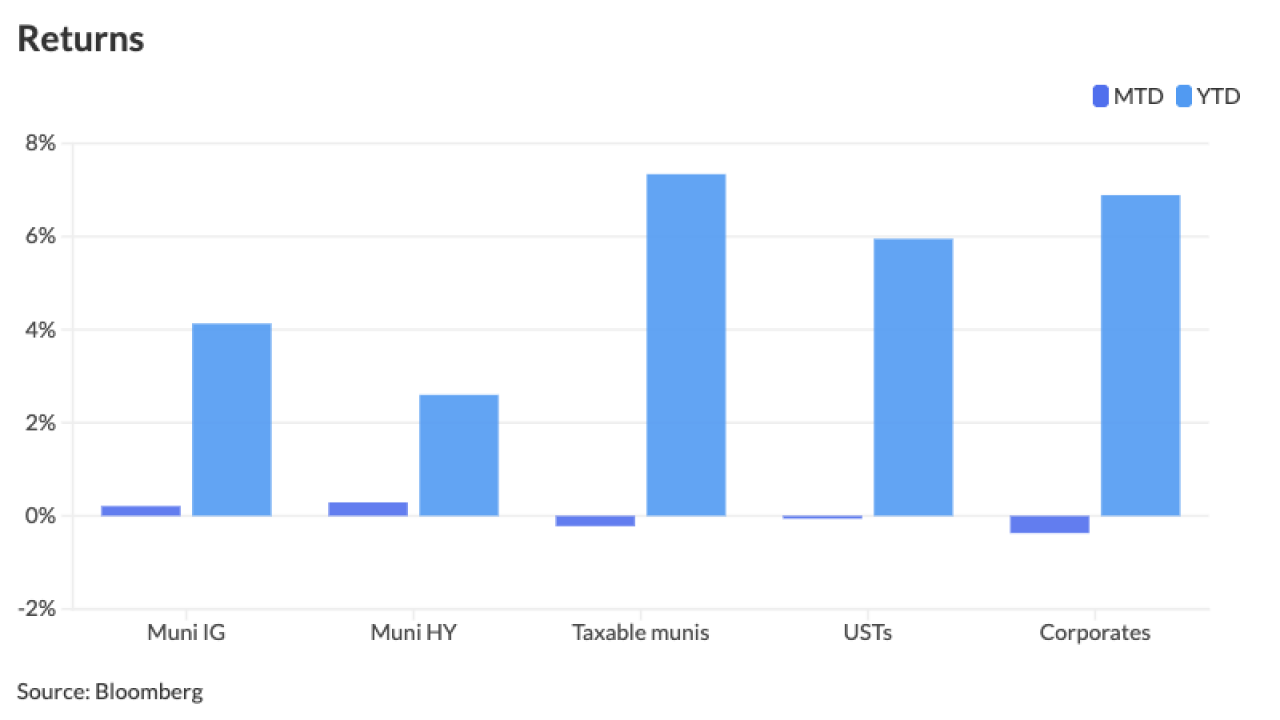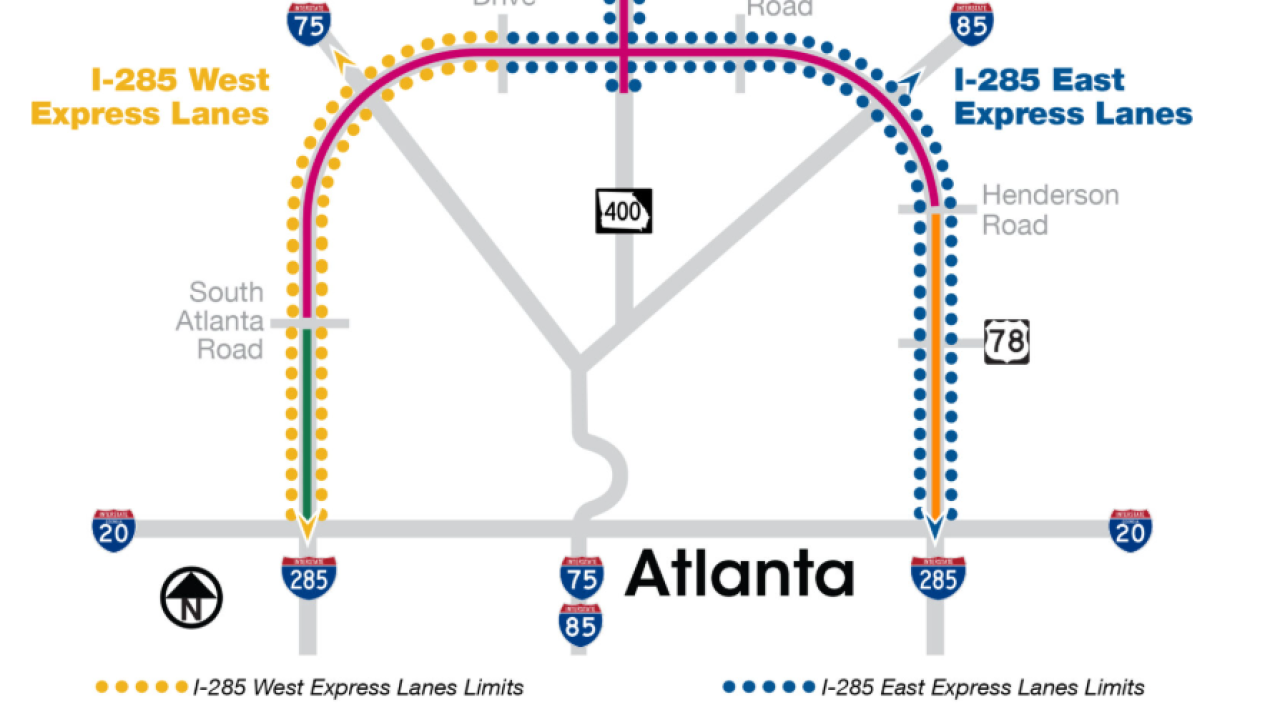Municipals were weaker in choppy secondary trading while the primary market was active with several large new-issues pricing amid another swing in U.S. Treasuries, which ended the day at lower levels three years and out in a risk-off trade. Equities ended another day in the red.
Triple-A benchmark yields rose up to three basis points, while UST yields fell up to 11 on the long end after hotter inflation numbers..
Municipal to UST ratios rose further as a result of the moves, pushing the 10-year just shy of 100%. Ratios were at 88% in five years, 99% in 10 years and 106% in 30, according to Refinitiv MMD's 3 p.m. read. ICE Data Services had the five at 88%, the 10 at 99% and the 30 at 108% at a 4 p.m. read.
Outflows continue with the Investment Company Institute reporting investors pulled $6.167 billion from muni bond mutual funds in the week ending May 4, up from $5.371 billion of outflows in the previous week.

In another active day in the primary Wednesday, Roosevelt & Cross priced for institutions $775.460 million of school districts revenue bond financing program revenue bonds for the Dormitory Authority of the State of New York with some cuts from Tuesday's retail offering.
The first tranche, $728.90 million (Aa3/AA/AA-/), of Series 2022A, insured by Build America Mutual — BAM's largest wrapped deal to date — (except for 2023, 2024 maturities), saw bumps on the one-year for institutional pricing and cuts on bonds 2037 and out from Tuesday's retail offering.
Bonds in 10/2023 with 5% coupon yields 2.28% (-2), 5s of 2027 at 3.01% (unch), 5s of 2032 at 3.59% (unch), 5s of 2037 at 3.83% (+3), 5s of 2042 at 3.97% (+3) and 4.25s of 2051 at 4.43% (+3), callable in 10/1/2030.
The second tranche, $26.680 million (/AA/AA-/), Series B, saw cuts up to six basis points s for institutional pricing. Bonds in 10/2023 with 5% coupon yield 2.20% (+2), 5s of 2027 at 2.96% (+6), 5s of 2032 at 3.52% (+3) and 5s of 2037 at 3.70% (unch), callable 10/1/2030.
Stifel, Nicolaus & Co. priced for the San Francisco Bay Area Rapid Transit District (Aaa//AAA/) $686 million of Election of 2016 general obligation green bonds, with 5s of 8/2024 at 2.25%, 5s of 2027 at 2.56%, 5s of 2032 at 2.93%, 5s of 2037 at 3.25%, 4s of 2047 at 4.18%and 4.25s of 2052 at 4.26%.
BofA Securities priced for Charlotte, North Carolina, $335.76 million of non-AMT and AMT Charlotte Douglas International Airport revenue bonds (Aa3//AA-/). The first tranche, $281.35 million of non-AMT revenue bonds, saw 5s of 7/2023 at 2.03%, 5s of 2027 at 2.79%, 5s of 2032 at 3.25%, 5s of 2037 at 3.56%, 5s of 2042 at 3.68%, callable in 7/1/2032; 4s of 2047 at 4.35% and 4s of 2052 at 4.42%.
The second tranche, $74.41 million of AMT revenue bonds, saw 5s of 7/2023 at 2.43%, 5s of 2027 at 3.16%, 5s of 2032 at 3.71%, 5s of 2037 at 3.95%, 5s of 2042 at 4.03%, 4.5s of 2047 at 4.40%, callable in 7/1/2032; 4.25s of 2052 at 4.50%.
BofA Securities priced for the City and County of Honolulu, Hawaii (Aa2//AA/) $226.815 million of wastewater system revenue green bonds. Bonds in 7/2026 with a 5% coupon yield 2.68%, 5s of 2027 at 2.78%, 5s of 2032 at 3.25%, 5s of 2037 at 3.56%, 5s of 2042 at 3.73%, 4.25s of 2047 at 4.34%, 5s of 2047 at 3.84%, 5s of 2051 at 3.90% and 5.25s of 2051 at 3.85%, callable in 7/1/2032.
A choppy secondary
Distribution remains clogged in "a crowded secondary market,” said Kim Olsan, senior vice president at FHN Financial.
While municipals have not moved in lockstep with UST, and munis have not moved as dramatically as taxables, in secondary trading there is "implied wiggle room in almost all offers," Olsan noted.
Bids wanteds remain elevated — running at a daily level of $1.6 billion this month, with $1.875 billion on Tuesday and $1.917 billion Monday — Olsan said sell situations are supplementing traditional bid processes.
Trading flows show "modest shifts in demand developing as the one- and three- to seven-year ranges drew more dealer buys from customers than sells on a net par value basis," Olsan said. "Of course, these areas carry limited risk for dealer commitments given strong demand for defensive posturing. Overall, dealer inventories as last reported on April 27 showed a $13.4 billion total, up 20% over the last month."
In addition to a supply/demand imbalance, absolute trading ranges have stymied better two-way municipal flows, she said, noting that in five-, 10- and 30-year munis this month yield spreads have been four to six basis points less volatile than their taxable counterparts.
"As a result, relative value ratios are 1-2 standard deviations off recent averages: the wings of the curve have implied 100% or greater ratios to USTs (in 5% coupons)," Olsan said.
Olsan noted that a 2.10% yield for AA bonds due in 2023 is a 2.65% TEY/21% bracket, 3.33% TEY/37% bracket and 3.62% TEY/37% federal plus 5% state bracket — "all well above comparable taxable levels."
Muni CUSIP requests fall
Municipal request volume declined in April, following a significant increase in March, according to CUSIP Global Services. For muni bonds specifically, there was a decline of 15.9%, and requests are down 12.3% year-over-year.
The aggregate total of identifier requests for new municipal securities — including municipal bonds, long-term and short-term notes, and commercial paper — fell 12.6% versus March totals. On a year-over-year basis, overall municipal volumes were down 13.5%.
NYC to sell $1.4B GOs
New York City said it will sell $1.38 billion of general obligation bonds the week of May 16, with $950 million of tax-exempt fixed-rate bonds, $300 million of tax-exempt variable-rate demand bonds and $130 million of taxable fixed-rate bonds. Proceeds will be used to fund capital projects.
Book-running lead manager BofA Securities is expected to price the tax-exempt and taxable fixed-rate bonds on Wednesday after a one-day retail order period. Citigroup, J.P. Morgan Securities, Jefferies, Loop Capital Markets, Ramirez & Co., RBC Capital Markets, Siebert Williams Shank, and Wells Fargo Securities will serve as co-senior managers.
Additionally, the city expects to sell $300 million of tax-exempt variable-rate demand bonds during the week of May 23, bringing the total bond sale amount to $1.38 billion.
Secondary trading
Minnesota 5s of 2023 at 2.07%-2.06%. North Carolina 5s of 2024 at 2.34%-2.07%. Utah 5s of 2024 at 2.31%. New York City 5s of 2024 at 2.40%-2.37%. Texas 5s of 2024 at 2.33%-2.32%. Hawaii 5s of 2024 at 2.36%-2.34%.
New York City TFA 5s of 2025 at 2.73%-2.65%. New York City 5s of 2028 at 3.11%. Georgia 5s of 2029 at 2.85%-2.80%. Louisiana 5s of 2030 at 3.02%-3.01%. Maryland 5s of 2030 at 2.85% versus 2.89% Tuesday.
Los Angeles DWP 5s of 2036 at 3.33%. LA DWP 5s of 2043 at 3.61%-3.50%. Ohio waters green bonds 5s of 2046 at 3.35%-3.47% versus 3.51% Monday.
Triborough Bridge and Tunnel Authority MTA Bridges and Tunnels payroll mobility tax 5s of 2051 at 4.04%-4.03%.
AAA scales
Refinitiv MMD’s scale was cut three basis points at the 3 p.m. read on bonds 2029 and out: the one-year at 1.97% (unch) and 2.29% (unch) in two years. The five-year at 2.56%, the 10-year at 2.91% (+3) and the 30-year at 3.24% (+3).
The ICE municipal yield curve was mixed: 2.02% (-1) in 2023 and 2.35% (-1) in 2024. The five-year at 2.56% (+2), the 10-year was at 2.86% (+2) and the 30-year yield was at 3.29% (+2) at a 4 p.m. read.
The IHS Markit municipal curve was mixed: 1.99% (unch) in 2023 and 2.29% (unch) in 2024. The five-year at 2.60% (unch), the 10-year was at 2.90% (+3) and the 30-year yield was at 3.24% (+3) at 4 p.m.
Bloomberg BVAL saw one to three basis point cuts: 2.01% (+1) in 2023 and 2.28% (unch) in 2024. The five-year at 2.61% (+1), the 10-year at 2.87% (+2) and the 30-year at 3.19% (+3) at a 4 p.m. read.
Treasuries were better three years and out.
The two-year UST was yielding 2.641% (+3), the three-year was at 2.825% (+3), five-year at 2.888% (-3), the seven-year 2.941% (-6), the 10-year yielding 2.917% (-7), the 20-year at 3.243% (-10) and the 30-year Treasury was yielding 3.021% (-11) at the close.
Inflation worries remain
The April consumer price index offered no real relief, with the annual reads dipping, but remaining well above the Federal Reserve’s 2% target, while the monthly figures showed the headline read decelerating but core accelerating.
"There’s not much to reassure the Fed in this release, despite the slight decline in the headline and core inflation rates on a year-on-year basis in April,” said Brian Coulton, Fitch Ratings chief economist.
“April’s hotter-than-expected CPI print will do little to assuage the Fed’s concerns over inflation that FOMC members have described as ‘much too high,’ and likely reinforces the probability of 50 bp rate increases at the June and July FOMC meetings,” said Mickey Levy, Berenberg Capital Markets' chief economist for the U.S. Americas and Asia.
It’s too early “to declare March a peak in inflation,” said Grant Thornton Chief Economist Diane Swonk. “There is too much uncertainty to go there given the ongoing war in Ukraine and ripple effects that lockdowns in China could still have on supply chains.”
Shelter costs — the biggest CPI component — will grow in the future, she said. “Rents and homeownership costs both accelerated during the month. … It takes at least a year for an acceleration in rents and homeownership costs to show up in inflation measures; both were still accelerating in the first quarter.”
But, taking a wider view, Wells Fargo Securities Senior Economist Sarah House and Economist Michael Pugliese noted, “restoring price stability was never going to be an easy task.” The report “served as a staunch reminder that the Fed has a long road ahead of it in bringing down inflation.”
And while base effects will help curb the annualized gains over the next few months, they said, “that will no longer be the case come mid-summer.” Expect a half-point increase at the June 14-15 FOMC meeting, House and Pugliese said, “with further hikes of that magnitude highly likely to follow.”
Although optimists may look at the report and say, “inflation has at least stopped getting worse … we doubt that it will be enough for the FOMC to signal a shift in tone. On an annualized basis the core CPI inflation experienced in April was still more than triple the FOMC's 2% target.”
And while market conditions, in past hiking cycles, may have led the Fed to slow rate hikes, House and Pugliese said, “with the underlying trend in inflation still well-above what the central bank considers desirable, we think the ‘all clear’ signal remains a ways off.”
With the Fed looking for inflation to cool to 2%, AXS Investments CEO Greg Bassuk said, “this red-hot April CPI could spark an even more aggressive interest rate escalation, which is feeding investors’ trepidation about an impending recession.”
Besides Fed action, he said, the war in Ukraine and greater supply chain concerns with China’s COVID lockdown have investors worried about recession. Volatility will remain “through Q2 and beyond,” Bassuk said.
Still, some good news can be gleaned from the report, said David Kelly, chief global strategist at J.P. Morgan Asset Management. “We expect some further moderation in the months ahead.”
Supply chains will improve and economic growth will drop this year, he said. “This should provide inflation relief and consequently we expect that the Fed will gradually moderate its recently hawkish tone, despite today’s hotter-than-expected report, thus providing support for recently battered U.S. fixed income and equity markets.”
While the report was in line with some forecasts, ING Chief International Economist James Knightley said, “the market had been looking for a larger moderation with consensus forecasts of 8.1% for headline CPI and 6.0% for core.”
Plus, he noted, the drop in energy prices in April “will be fully reversed next month given gasoline is back at all-time highs.”
But, he believes, that “March 2022 will have marked the peak for annual inflation.” With used car prices — which carry a heavy weight in the CPI basket — declining, and a shift toward services from goods, expect “a gradual moderation in the rate of inflation,” Knightley said. “Nonetheless, we remain nervous about the impact from gasoline and the growing price pressures within services.”
But the big three keeping inflation up — geopolitical issues, supply chain snags and labor shortages — show “little sign” of a quick resolution.
Additionally, housing will remain a driver of sticky inflation, he added.
So, pressure remains for “aggressive rate hikes and the risks of a marked slowdown/recession.” Knightley sees 50 basis point hikes at the next three meetings and 25 basis point increases “from November onwards with the target rate peaking at 3.25% in early 2023.”
But despite the higher rates and some supply-side improvement, he said, “we have doubts that CPI will get back to the 2% target before the end of 2023.”
Don’t expect a deceleration in inflation until the fall, said Jay Hatfield, CEO and CIO at Infrastructure Capital Management, when energy prices will “peak and housing and rent price increases to decelerate.”
And it will be the Fed’s job to rein in inflation, said Morning Consult Chief Economist John Leer. "In terms of the White House's inflation proposal, it's hard to see how that proposal will meaningfully change near-term inflation."
While long-term inflation can be fixed at the federal level, “many of the obstacles preventing an expansion of affordable housing are at the state and local level,” he said. “I appreciate the political challenges that inflation poses to the White House, but I don't think there's a lot that they can do on this issue over the next few months."
Primary to come:
The Harris County Cultural Education Facilities Finance Corp., Texas, is set to price Thursday $277 million Memorial Hermann Health System hospital revenue bonds, consisting of $170 million of fixed rate bonds, Series 2022A; $55 million of fixed-rate puttable bond, Series 2022B; and $52 million of fixed-rate notes, Series 2022C. J.P. Morgan Securities.
Georgetown, Texas, (/A+//) is set to price Thursday $223.330 million of utility system revenue bonds, Series 2022. Morgan Stanley & Co.
The Industrial Development Authority of the City of Phoenix, Arizona, is set to price Thursday $199.926 million of All Sports Village Project economic development revenue bonds, consisting of $180.660 million of tax-exempt bonds, Series 2022A, $6 million of taxable bonds, Series 2022B and $13.266 million of tax-exempt, Series 2022C. D.A. Davidson & Co.
The Bay Laurel Center Community Development District, Florida, (/AA//) is set to price Thursday $126.770 million of taxable water and sewer revenue bonds series 2022B, serials 2024-2032, terms 2042 and 2052, insured by Assured Guaranty Municipal Corp. Jefferies





